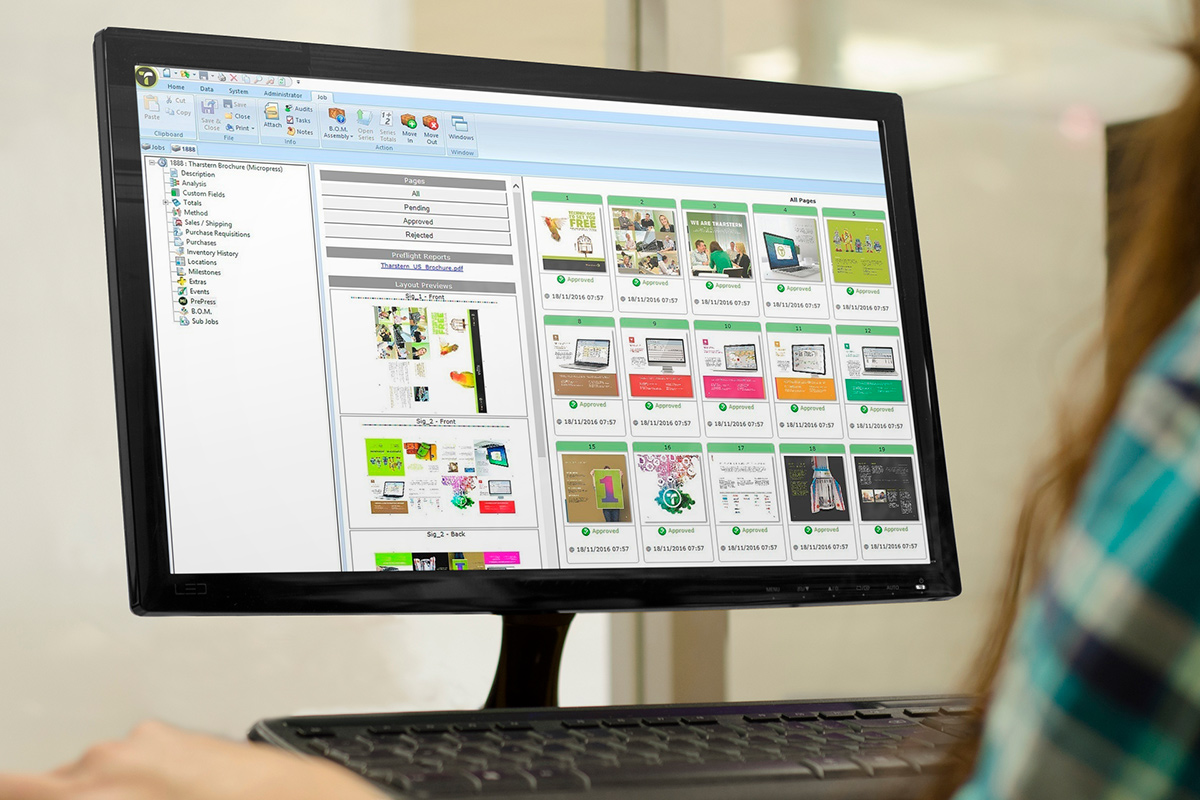When it comes to installing management information systems, all sorts of horror stories circulate in the large-format print space. Print company chiefs talk at length about the lack of sector-specific systems/modules, wasted time and money. So what’s being done to lay these concerns to rest?

If there’s a name that crops up more than any other when it comes to talking about MIS to those running a large-format orientated PSP it’s Tharstern – so an obvious starting point for a feature like this. According to the company’s chief business development officer Lee Ward, the company has identified a number of key concerns when it comes to the purchase and deployment of MIS in this sector. “Wide-format printers need a solution that can easily cope with complex campaigns and quote for different stores and different store profiles. They need an MIS that can easily create complex multi-element estimates, that gangs jobs together for production and then delivers the separate elements as one order. Estimates need to be able to include things such as installation services, travel, vehicle and machinery hire and subsistence,” he says. Yup, that sounds about right, so what is Tharstern - and other players - doing about it?
“We are addressing those needs by ensuring that our MIS allows printers to manage multi-job campaigns throughout a workflow, that it can group multiple estimates into a project and manage them as a whole, so a single quote letter can be produced, which will combine the details and pricing for all products in the project. We have also worked hard to implement advanced imposition techniques that provide production efficiencies for this sector,” says Ward.
“The latest version of Tharstern contains even more functionality for wide-format users - we’ve been working on the estimates that our clients can create for their multi-job, multi-site campaigns. Users can now quote for campaigns that include a number of different packs, with unique configurations for each. The quotes can include project level services such as artworking and design, installation services such as accommodation and mileage, and include print estimates in that too. The new functionality also allows user to assign unidentified goods received into a wide-format job, so users can deal with client supplied items that have been received without knowledge of which job they have been supplied for.”
According to Ward, Tharstern is ideal for printers who work with more than one type of print, claiming “they’ll only ever need one MIS to quote for and manage all their print jobs”. He adds: “Our MIS has had to evolve with the changing needs of our customers, a good number of which have diversified into other types of print.”
It’s diversification that is having a key impact on how Imprint is developing its offering – but here it’s more about targeting those print companies newly breaking into digital large-format than about established players within the sector extending their services.
MIS project manager Pete Horwood says: “We continue to monitor the trends in the large-format sector and are at present looking at ways of presenting wide-format solutions to customers that are introducing wide-format into their business model and ensuring our systems integrate and work with any existing systems in place.”
Asked what Imprint takes the main concerns of the large-format sector to be in relation to MIS, and how the company is addressing that, Horwood says: “One of the biggest concerns that we hear when speaking to wide-format customers is they want to talk to suppliers that have an understanding of how a large-format printing business differs from a more conventional printers. They want to talk technical and in depth to someone who has a sound understanding of large format production - for example, the ability to be able to quickly generate quotes and easily modify them with out starting all over again.
“We realise that a lot of the concerns that affect traditional printers such as which machine to choose to produce a particular product, based on volume or the speed of the machine doesn’t really apply to wide-format. The wide-format printer will generally already know what machine they will be using to print and cut and they will want their material costs in square metres for example. Basically, the LF printer needs a system that isn’t confined by the number of input touch points that might be required in a traditional system.”
To that end Horwood points out that Imprint has “produced a quick estimating module that is more tailored for projects like kitting, with a multi-picker function that is less rigid than traditional print estimating modules. Cost centres are set up in the background for processes that need material and cost rates assigned to them, but for more straightforward items such as external contract labour for example, a standard cost and selling rate can be applied.”
But many large-format PSPs are looking way beyond that kind of functionality, with MIS and workflow integration a priority. Jonathan Rogers, international marketing manager, Onyx Graphics, puts it simply: “Speaking solely as a software provider for digital inkjet wide-format printing to PSPs, a trend we’ve seen grow tremendously in recent years is the need for data. PSPs are concerned about human input error or job estimation, costs and are seeking print production business tools to make data driven business decisions. Vendors are seeking new ways to provide the kind of tools that help PSPs gain access to such data that could help them answer questions such as ‘Did I make money on that job?’ and ‘Did I estimate that correctly?’ or ‘What is my media waste?’.
“Business owners and production managers need to see real-time, historic and trend data from their entire production site in one central hub location. Typically, this process requires people to manually gather data or rely on manual input, which wastes time and isn’t accurate. They need a system to easily see actual data that helps them make better business decisions.”
To this end Rogers points to the Onyx Hub, saying: “Onyx Hub 2.0 the first business intelligence tool designed specifically for wide-format print. It is a business intelligence tool that provides real-time, historic and trend print production data across an entire production environment in a browser-based dashboard. Users can see and report on actual data and actual job costs to help establish the right print production workflows that help eliminate bottlenecks and identify areas of waste.”
Over at Agfa, Bobby Grauf, sales manager UK and Ireland, says the company brings its “extensive MIS integration knowledge from litho and cut-sheet digital printing to wide-format in the latest release of Asanti Production.”
There are three different business models: hotfolder based automation; XML driven; full JDF/JMF integration. Each model reduces the amount of everyday tasks. With a fully integrated JDF link, the Asanti Production workflow is a processing and automation ‘black box’ that receives, executes and delivers job information and content to all connected printers, and feeds its results back to the MIS system.
“The first reaction when talking to large-format PSPs about MIS is that there is simply too much variation from job to job to automate print production workflows and MIS. Just looking at the order book can put people off thinking of MIS integration because it looks too big to handle. It’s why we always aim to start small and build up to full integration over time. Quick and intermediate wins will give the feeling of achievement. It also proves to every stakeholder in the business that automation is an improvement over more labour-intensive manual steps.
Fujifilm Graphic Systems Europe workflow product management and support manager John Davies also flags up the extent of the MIS/workflow solution ask.
“Our industry has strived to make the link between MIS systems and production possible via the use of JDF connectivity, this however is far from a simple plug and play approach to integrating products, as it often requires software changes to be made by both the MIS vendor and the production software vendor to make the integration really flow. What can be achieved is automated production initiated from the MIS system with communication of time taken, media use and other information fed back from the print process. The price however, for undertaking such a project, is probably too high for the typical mid to small wide-format print supplier.”
Fuji is addressing the issue by focussing on making improvements to production layout and planning using tilia Griffin products for smaller production needs, and tilia Phoenix for more demanding production requirements. These products assist with efficient layout of jobs to be printed, and can be optimised for either the fastest way to print, the most efficient use of media space, or the overall cheapest way to print a selection of jobs.
“We are seeing more demand for systems to automatically plan incoming work and for this we are using Enfocus Switch which has very good integration with both tilia Griffin and tilia Phoenix,” says Davies, pointing out that both products are scalable and offer a solution for managing production flow and managing cost together within one product.
He adds: “Typically, equipment suppliers provide a front end workflow for their kit. Our aim with products such as Enfocus Switch, tila Griffin and tilia Phoenix is create a job planning platform that can be applied to all the printing equipment a company uses so that any investment will bring efficiency and cost management benefit to the whole business.”
How far off is the day when large-format PSPs feel MIS delivers the kind of ROI they continue to seek in this rapidly evolving technological landscape?


